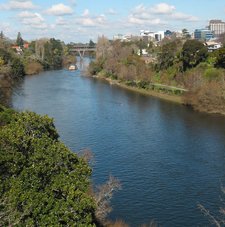Waikato
|
|
Position_of_Waikato_Region.png
Waikato Region
Waikato is the name of a region in the North Island of New Zealand. Exact boundaries of the region depend largely on the use of the name, but in all cases it refers to an area around the city of Hamilton and extending along the banks of the Waikato River.
| Contents |
Different definitions
The Waikato local government region
The Waikato Region is a local government region on the western side of the North Island. It stretches from Lake Taupo and northern King Country in the south, up to the Coromandel Peninsula and the boundary with the Auckland Region. The region has an area of 25,000 km 2, and an estimated 2004 population of 381,900.
The Waikato region (general use of term)
The term Waikato is likely to generally include only a part of the local government region, excluding areas around the Coromandel Peninsula and Thames Valley in the north and around and to the north of Lake Taupo in the southeast.
The Waikato District
Waikato also refers to the district administered by the Waikato District Council. This covers the towns of Ngaruawahia, Huntly and Raglan.
The Waikato River
The Waikato refers to to the long river from which the region gets its name. Waikato is a Maori word meaning flowing water.
Geography
In the west, the region is bounded by the Tasman Sea. The coastal region is largely rough hill country, known locally as the Hakarimata Range, though it is more gently undulating in the north, closer to the mouth of the Waikato River. The coast is punctured by three large natural harbours: Raglan Harbour, Aotea Harbour, and Kawhia Harbour. The area around Raglan is noted for its volcanic black sand beaches, and also for its fine surfing conditions.
To the east of the coastal hills lies the broad floodplain of the Waikato River. The region has a wet temperate climate, and the land is largely rich farmland, although it also contains undrained peat swamp. It is in the broad Waikato Plains that most of the region's population resides, and the land is intensively farmed with both livestock (mainly dairy cattle) and crops (such as maize). The area around Cambridge has many thoroughbred stables.
The north of the region around Te Kauwhata produces some of New Zealand's best wines. Several shallow lakes lie in this area, the largest of which is Lake Waikare.
To the east, the land rises towards the forested slopes of the Kaimai and Mamaku Ranges. The upper reaches of the Waikato River are used for hydroelectricity, and several large artificial lakes are found in the region's southeast.
History
Prior to the arrival of Europeans, the western North Island contained some of the most densely populated parts of New Zealand, inhabited by iwi such as Ngati Toa and Tainui.
The Waikato has a prominent history, particularly regarding relationships between Maori and European in early colonial New Zealand. During the Land Wars of the 1860s, the Waikato was the scene of major bloodshed in what is referred to as the Invasion of the Waikato. Largely in retaliation for Waikato Maori helping Taranaki Maori protect their land in the earlier Taranaki War, the colonial government - with the help of troops brought from Britain - pushed south from the main settlement of Auckland, fighting several defensive lines organised by the combined iwi of the King Movement. During 1863 and 1864 fighting occurred at Meremere, Ngaruawahia, Rangiaowhia (southwest of Cambridge) and at Orakau (near Te Awamutu). Eventually the King Movement's forces pulled back to positions in the area to the south of the Waikato, still known as the King Country. The Orakau siege was immortalised in one of New Zealand's first motion pictures as Rewi's Last Stand in 1925.
The National Marae, Turangawaewae, is at Ngaruawahia. It is the seat of the Maori Queen, Te Atairangi Kaahu.
People
Cities and towns
The city of Hamilton is the major centre, with a population in 2005 of 197,000. It is home to Waikato University. The towns of Tokoroa, Te Awamutu and Cambridge each have between 10,000 and 15,000 people.
The region also includes the smaller towns of Huntly, Matamata, Morrinsville, Ngaruawahia, Otorohanga, Putaruru, Raglan, Te Kauwhata, Te Kuiti, and Tirau.
Other towns within the Waikato government region, but outside the normally accepted Waikato area, include Waiuku, south of Auckland; Paeroa, Te Aroha, Thames, Whangamata, and Whitianga around the Thames Valley and Coromandel Peninsula; and the city of Taupo (population 21,000) and town of Turangi in the southeast.
The people of the Waikato occasionally use the nickname Mooloo to apply to themselves or to their province, particularly in relation to sporting endeavours. The origin of the word is unknown.
Famous sons and daughters
- Jim Bolger - former Prime Minister of New Zealand
- Helen Clark - current Prime Minister of New Zealand
- Don Clarke - Rugby international
- The Datsuns - rock band
- Tim and Neil Finn - songwriters and musicians
- Bruce McLaren - Motor racing driver and team founder
- Colin Meads - Rugby international
- Frank Sargeson - writer
- Mark Todd - Olympic equestrian
- Te Atairangi Kaahu - current Maori Queen
- Te Puea Herangi - Maori leader
- Te Rauparaha - Maori chieftain and warrior
External links
- Environment Waikato / Waikato Regional Council (http://www.ew.govt.nz/)
- Tourism Waikato (http://www.waikatoNZ.com/)

